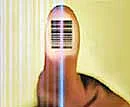

The UIDAI’s perception stems from its belief that while photographs may visually testify who you are, they will not reveal your true identity because, in this day and time of digital morphing, you may not be who you say you are.
The ten-member committee, chaired by Registrar General of India (RGI) C Chandramauli, has observed in its report, accessed by Deccan Herald, that a fingerprints-based biometric system shall be the core of UIDAI’s de-duplication efforts.
Arguing that while face is the most commonly captured biometric and frequently used in manual checking, the committee has noted that stand-alone automatic facial recognition does not provide high levels of accuracy.
Therefore, fingerprinting will be at the core of vetting duplications as UIDAI goes about its task of providing unique IDs to India’s billion-strong population. The panel noted face recognition can only be used to supplement a primary biometric modality. Over 250,000 fingerprint images were sourced from Delhi, Uttar Pradesh, Bihar and Orissa, for this exercise. It was undertaken by a four-member fingerprint sub-committee.
According to the committee’s submission, despite the agencies involved in the exercise were different and disparate, quality of fingerprint obtained were as good as seen in developed countries providing for 99 per cent accuracy in de-duplication. Nearly all images were from rural regions and were collected by different agencies using different capture devices and through different operational processes.
Besides fingerprints, the panel notes that demographic data is also used for improving de-duplication processes.
The committee, which has recommended that ISO 19794 series of biometrics standards for fingerprints, face and iris set by International Standards Organisation as being most suitable, has said that besides photograph, ten fingerprints of the person being enumerated must be obtained for enrolment.
Suggesting that UIDAI will maintain single facial image captured from digital still-image camera which will be primarily used for human visual inspection and only as secondary means of authentication /de-duplication, the panel has called for designing a scheme to reward enrolling agencies to capture good quality images.
Likewise, it has called for establishment of centres for ongoing biometrics research to provide reference implementation of enrolment process software designed for Indian conditions.
